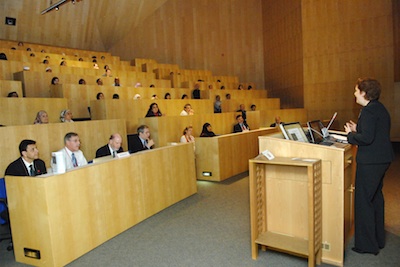Brain Malformations in Focus at Neurogenetics Workshop
April, 2011

M. Elizabeth Ross, M.D., professor and vice chair of neurology at Weill
Cornell Medical College in the US, discusses the latest findings on brain
malformations and and their implications.
Scientists in Qatar and the region, the United States and Italy gathered in Doha recently to share the latest findings on brain development and malformation and strategies to improve diagnosis and treatment of affected individuals.
“Congenital brain malformations affect an estimated two percent of the population worldwide and pose a significant health care challenge for families and communities,” said M. Elizabeth Ross, M.D., professor and vice chair of neurology at Weill Cornell Medical College in the US, who organized the Neurogenetics Workshop 2011 with colleagues at Shafallah Medical Genetics Center and Hamad Medical Corporation.
“Among our major goals for this workshop are increased awareness of brain malformations and improving the precision of diagnosis. These are necessary steps toward finding betters ways to manage disabilities and seizures that can occur in these conditions,” said Dr. Ross, who discussed current understanding of the major molecular and cellular events of early brain development at the workshop.
“In recent years, several genes related to epilepsy have been identified,” said Haten El-Shanti, M.D., director of the Shafallah Medical Genetic Center and co-organizer of the conference, who discussed genetic causes of seizures in children at the workshop. “The Middle East is an important area of research in this field because the population is unique. The frequency of consanguineous marriages in the region increases the incidence of congenital or inherited disorders in the population, which, in turn, increases the likelihood that causative gene changes leading to the disorder can be identified."
Advances in medical imaging have helped to identify functional areas of the brain, said Dr. James Barkovich, professor of radiology at the University of California at San Francisco. “We have a much better idea of what part of the brain is doing what,” said Barkovich, who discussed the latest advances in imaging in relation to the diagnosis of brain malformations.
A variety of imaging tools and the growing knowledge of genetics is improving our understanding of the underlying causes of brain malformations and helping find new genes related to the disorders, according to Dr. William Dobyns, professor of pediatrics at the University of Washington.
Better understanding of the functional areas of the brain has helped to improve treatment for disorders related to brain malformations. For example, it is now possible to surgically remove certain areas of the brain to treat cases of epilepsy that don't respond well to medication, said Dr. Renzo Guerrini, professor of child neurology and psychiatry at the University of Florence, who discussed genetic causes and presentations of seizures in children.
Other speakers at the workshop included Dr. Hussein Kamel, senior consultant in radiology, and Dr. Mahmoud Fawzi Elsaid and Dr. Khalid Ibrahim, senior consultants in pediatric neurology at Hamad Medical Corporation; Dr. Alice Abel Aleem, director of the neurogenetics laboratory at WCMC-Q; and Dr. Tawfeg Ben Omran, head of clinical and metabolic genetics at Hamad Medical Corporation.
The conference allowed participants to discuss strategies for optimizing brain imaging and the management of seizures and of other medical issues commonly encountered in patients affected by these disorders. Conference participants were invited to bring their most challenging cases for discussion to advance diagnosis.
By Kristina Goodnough
